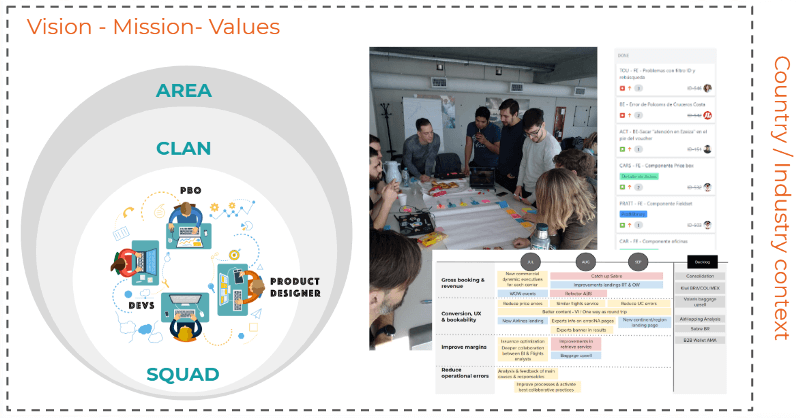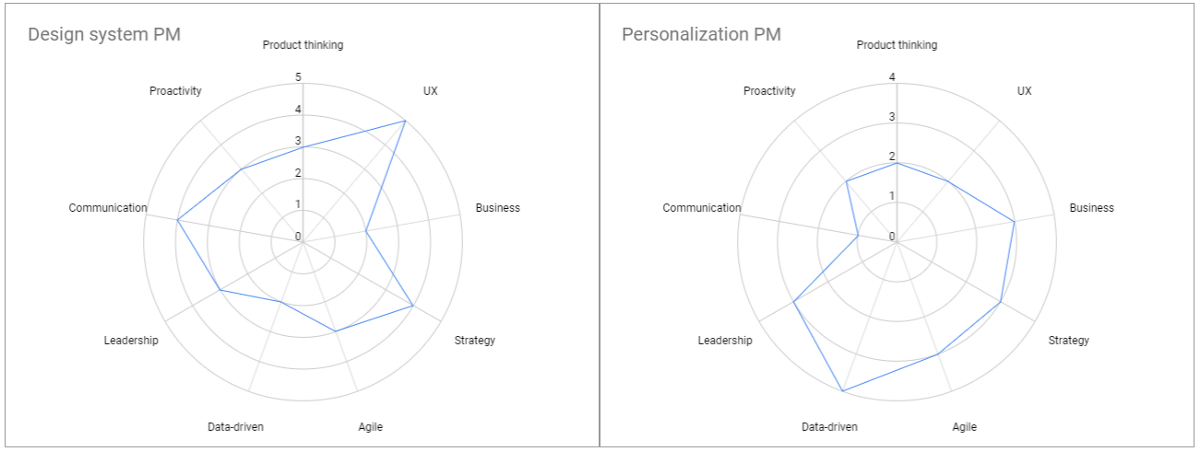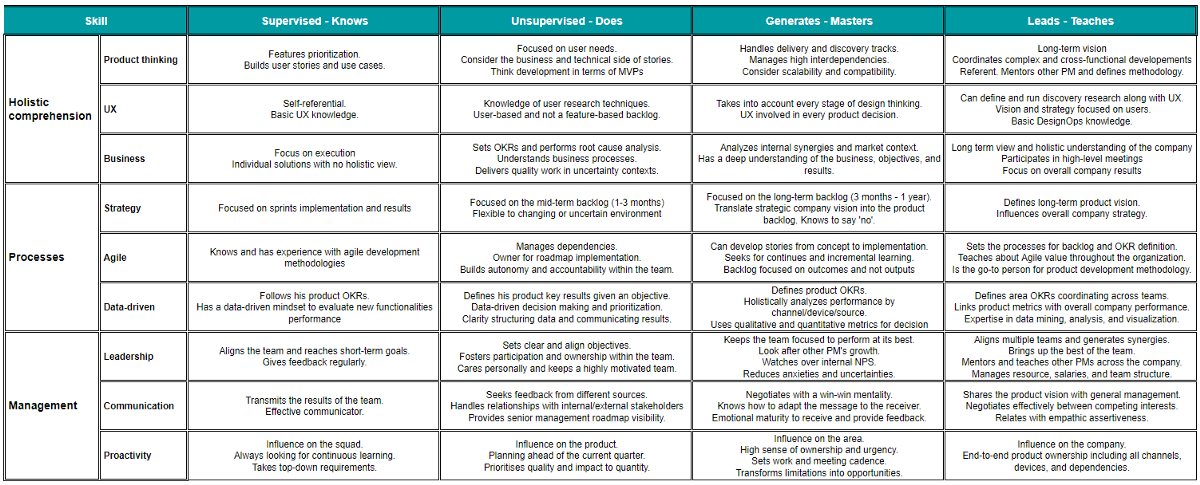How we Developed a Talent Growth Plan at Almundo [Mind the Product]

At Latin American travel technology company Almundo, we believe that leaders are responsible for the people, whether that is via one-on-one meetings, career opportunities, company culture, or employee satisfaction. So, it was natural that we should want to develop a talent growth plan for our people. This is how we did it.
Each month we send out an NPS survey to assess whether the company is being a great place to work, but a few months ago I also sent Google’s manager feedback survey to my team of 10 product managers. All of them are accountable for a squad (about five developers and one user experience professional).
The Google manager feedback survey is about a dozen statements with a Likert scale (1-5) to measure if they agree or disagree with the statements.
The results showed that they wanted better (and more frequent) feedback on how to further develop their product management skills.
It was clear the team needed a talent growth plan. Therefore, as a goal, we decided we wanted every product manager to be able to answer these two questions:
- Where do I want to go?
- How will I pace myself to see if I am getting there?
Every Journey Begins With the First Step
In order to set competencies, we needed to understand the role and responsibilities of a product manager. Martin Eriksson’s Venn diagram shows product management as the intersection between UX (usable), IT (feasible) and Business (valuable) – we also wanted to figure out whether a product manager needs to know how to code, or build an app or just speak with a developer? Is UX about being customer-centric, or should they be able to build a high fidelity prototype or run JTBD interviews? Does a product manager need to know about online marketing, brand building, understand a P&L statement, or machine learning algorithms?
Expert Analysis and Benchmarking
We set out to uncover all we could about how others addressed this topic. We analyzed dozens of job descriptions from leading companies (Airbnb, Amazon, Booking, eBay, Expedia, Instagram, Intercom, LinkedIn, Netflix, PayPal, Spotify, among others) and we were able to differentiate hundreds of distinct skills and responsibilities.

Mixing the words, key responsibilities across companies started to emerge:
- Define product vision and strategy
- Team execution and development
- Define/research/deliver customer experience
Next, we looked to see if other businesses had already built a career development plan. In the main, we found skills matrices broken down by seniority. The product manager career path at XO and the “levels framework” from the book “Org Design for Design Orgs” (by far the best book I’ve read on UX management) were amazing and helpful resources.
We then made our first decision: we would use a matrix for talent growth discussion and would not set organizational hierarchy. We decided against an extensive and binary matrix where you have to check several to-dos to get a promotion. We wanted to be objective and flexible. We aimed for a small matrix with general skills that could foster healthy and insightful conversations.
Seeing the big Picture
Argentine philosopher Mario Bunge holds that everything is either a system or a component of one. He defined a system as the conjunction of its composition and structure (C&S), the environment (E), and the mechanisms (M) that make it yield results.
The richness of the model relies on defining the individual attributes that a product manager needs to have while also highlighting the critical importance of their work as part of a team. Systemism rejects the myths that the individuals are not important (holism) and that the system is just the sum of its parts (individualism).
Therefore:
- Composition and structure would be how we group ourselves into squads, squads into clans, and clans into tribes, mimicking the Spotify model
- Mechanisms would be our processes used to translate the company vision into product strategy, prioritize and set each clan’s backlog and to get it done sprint by sprint
- Context would be externally the travel industry and travelers in Latam, and internally our vision and mid-term strategy
Adding the skills and responsibilities, we define three elements with three skills each. This is the backbone of our talent growth matrix:
Holistic comprehension (E):
- UX: Deep user understanding. Design thinking mindset (empathize, define, devise, prototype, evaluate).
- Business: Mastery of key metrics, trends, best practices and main players in the market.
- Product thinking: User-centered product development, iteration, and MVPs, backlog management, scalability, execution.
Processes (M):
- Strategy: Translation of the mission and vision into a coherent product strategy.
- Agile: Product owner role, software development, team cadence, delivery.
- Data-driven: Decisions based on objective criteria. Mastery of web metrics and tools. Knowledge of data visualization, mining and statistical inference
Management (C&S):
- Leadership: Influence, develop and guide the team towards strategic goals. Ability to delegate, manage and motivate.
- Communication: Transmit ideas with clarity. Achieve consensus. Active listening.
- Proactivity: The willingness to act between stimulus and response. Getting things done. Ownership.
With the skills agreed, the next step was to define growth across each dimension. As I said before, we didn’t want the skills matrix to be seen as a ladder but as a web where each person could focus on developing the best skills for their product and aligned with their interests.
This way, you could have an excellent design system product manager and an outstanding personalization product manager, each with quite different skills charts:
Moreover, you could overlap the shape of all your product manager skills charts and find out where are your strengths and weaknesses as a team.
The Skills Growth Matrix
After many cycles of feedback and iteration this is what our forever work-in-progress skills matrix looks like:
The talent growth matrix is now being used by all product managers at Almundo (there are 18 of us). The UX team (12 product designers) also make use of a modified version of the matrix (with UX skills).
Since we presented the matrix, we’ve been able to unify criteria across different processes like recruiting, feedback and promotions. We’ve done a first evaluation of every product manager against the matrix and set half-year action plans focusing on main opportunities. We’ve also improved our interviewing process by using an empty matrix to objectively assess new candidates.
Summing up, we have achieved our goal of finding common ground within the team on the skills every product manager needs to have and what should be accomplished to develop them further.
The statistician George Box said that “all models are wrong, but some are useful”. Here is our path towards building a product manager growth framework, not good nor bad, but ours. I hope you find it useful, and that you also find yours!
Takeaways
- We developed the skills matrix as a tool for talent growth and not to set organizational hierarchy. We wanted a framework over which we could debate, guide, listen, discuss progress, and find growth opportunities.
- We set the skills by conducting extensive research and iterating based on our team feedback. Then, we broke them down into groups using a systemic approach.
- Seniority emerges as a result of the skills mastery, area of influence and the time-horizon of decision making.
- Talent growth goes from learning to practising to mastery to teaching.
- The matrix allows unifying criteria across different processes like recruiting, performance evaluation and feedback.
Reference and inspiration
Books
- Emergencia y convergencia – Mario Bunge
- Org design for design orgs – Peter Merholz & Kristin Skinner
- Inspired – Marty Cagan
- ReWork – Jason Fried & David Heinemeier Hansson
- High Output Management – Andy Grove
- The hard things about hard things – Ben Horowitz
Articles
- What, exactly, is a Product Manager? — Mind the Product
- CEO of the Product Revisited | Silicon Valley Product Group
- Product Manager Skills By Seniority Level — A Deep Breakdown
- Product managers for the digital world
- What It Takes to Become a Great Product Manager
- What makes for a good Product Manager?
- Product Management Tool For Product Excellence – productboard
The post How we Developed a Talent Growth Plan at Almundo appeared first on Mind the Product.
Source: Mind the Product https://www.mindtheproduct.com/how-we-developed-a-talent-growth-plan-at-almundo/






Post a Comment